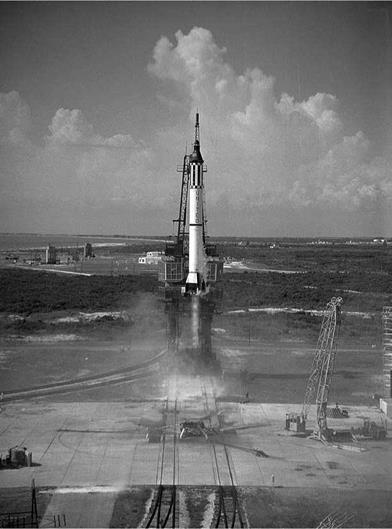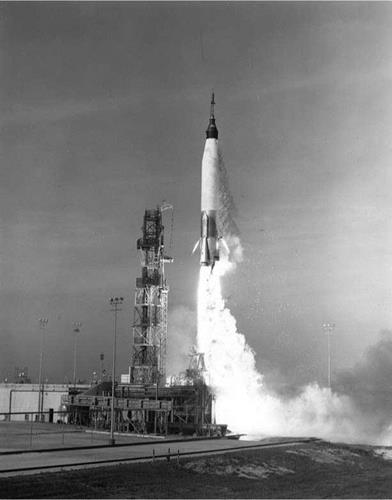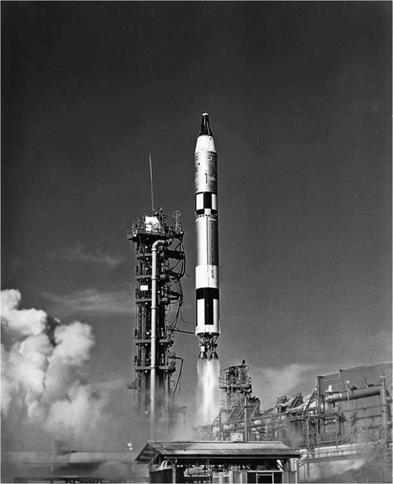"Man-Rating"
 One major area of difference between missile and launch-vehicle development lay in the requirement for special safeguards on launch vehicles that propelled humans into space. Except for Juno I and Vanguard, which were short-lived, among the first U. S. space-launch vehicles were the Redstones and Atlases used in Project Mercury and the Atlases and Titan IIs used in Project Gemini to prepare for the Apollo Moon Program. Both Projects Mercury and Gemini required a process called “man-rating" (at a time before there were women serving as astronauts). This process resulted in adaptations of the Redstone, Atlas, and Titan II missiles to make them safer for the human beings carried in Mercury and Gemini capsules.
One major area of difference between missile and launch-vehicle development lay in the requirement for special safeguards on launch vehicles that propelled humans into space. Except for Juno I and Vanguard, which were short-lived, among the first U. S. space-launch vehicles were the Redstones and Atlases used in Project Mercury and the Atlases and Titan IIs used in Project Gemini to prepare for the Apollo Moon Program. Both Projects Mercury and Gemini required a process called “man-rating" (at a time before there were women serving as astronauts). This process resulted in adaptations of the Redstone, Atlas, and Titan II missiles to make them safer for the human beings carried in Mercury and Gemini capsules.
Man-rating was but one of the ways missiles had to be modified for use as launch vehicles, but the practice carried over to later launch vehicles initially designed as such (rather than as missiles). For Mercury-Redstone, Wernher von Braun’s Development Opera-
A Mercury – Redstone launching Freedom 7 with Astronaut Alan Shepard onboard,
![]()
 May 5, 1961, from Pad 5 at Cape Canaveral. (Photo courtesy of NASA)
May 5, 1961, from Pad 5 at Cape Canaveral. (Photo courtesy of NASA)
tions Division of the Army Ballistic Missile Agency was respon – 50 sible for the process. Von Braun established a Mercury-Redstone Chapter 2 Project Office to aid in redesigning the Jupiter C version of the Redstone to satisfy the requirements of the Mercury project. To direct the effort, he chose Joachim P. Kuettner, a flight engineer and test pilot who had worked for Messerschmitt during the Nazi period in Germany.2
Kuettner’s group recognized that the Redstone missile could not satisfy the mission requirements for Project Mercury. These necessitated sufficient performance and reliability to launch a two – ton payload with an astronaut aboard into a flight path reaching
an apogee of 100 nautical miles (115 statute miles). The Jupiter C, with its elongated propellant tanks and a lighter structure, had the required performance but not the safety features necessary for human flight. To add these, Kuettner’s group reverted from the toxic hydyne to alcohol as a fuel. Other changes included an automatic, in-flight abort system with an escape rocket and parachutes to carry the astronauts to a safe landing. To ferret out potential sources of failure, Chrysler, as prime contractor, instituted a special test program to promote greater reliability. The overall process proved successful, resulting in the two flights of Alan Shepard and Virgil (Gus) Grissom in May and July 1961.3
Thereafter, Project Mercury switched to Atlas D missiles to propel the astronauts and their capsules into orbit. For this function, the missile required strengthening in its upper section to handle the greater loads the capsule created. Following an explosion on Mercury-Atlas (MA) 1 (July 29, 1960), whose cause investigators could not determine, engineers developed an improved structure linking the booster and capsule, resulting in a successful flight of MA-2 on February 21, 1961.4 MA-2 also tested the Atlas abort sensing and implementation system (ASIS) and “escape tower" that were key features in man-rating the Atlas. Besides these two features, there had to be numerous other modifications to convert Atlas to its Mercury-Atlas configuration. For example, the Mercury capsule’s separation rockets potentially could damage the thin “steel-balloon" skin on the liquid-oxygen dome of the Atlas, so General Dynamics (formerly Convair) engineers had to add a fiberglass layer covering the dome. This and other changes, plus increased quality control, caused the Mercury-Atlas launch vehicle to cost 40 percent more than the Atlas missile. After a failure on MA-3 (due to guidance/ control problems), Atlas launch vehicles placed John Glenn, Scott Carpenter, Walter Schirra, and Gordon Cooper in orbit between February 20, 1962, and May 15, 1963.5
 For Titan II-Gemini, there were major problems with longitudinal oscillations in the engines, known as pogo (from their resemblance to the gyrations of the then-popular plaything, the pogo stick). These never occurred in flight but appeared in a severe form during static testing of second-stage engines. Surges in the oxidizer feed lines were causing the problem, which Martin engineers and others solved with suppression mechanisms. There was also the issue of combustion instability that occurred on only 2 percent of the ground tests of second-stage engines. But for man-rating, even this was too high. Aerojet (the Titan engine contractor) solved the problem with a new injector.6
For Titan II-Gemini, there were major problems with longitudinal oscillations in the engines, known as pogo (from their resemblance to the gyrations of the then-popular plaything, the pogo stick). These never occurred in flight but appeared in a severe form during static testing of second-stage engines. Surges in the oxidizer feed lines were causing the problem, which Martin engineers and others solved with suppression mechanisms. There was also the issue of combustion instability that occurred on only 2 percent of the ground tests of second-stage engines. But for man-rating, even this was too high. Aerojet (the Titan engine contractor) solved the problem with a new injector.6
 |
 |
For other aspects of man-rating Titan II for Gemini, procedures developed for Project Mercury offered a strong influence, especially 52 as many NASA and Aerospace Corporation engineers who had Chapter 2 worked on Mercury also worked on Gemini. Gemini engineers also benefited from Titan II test launches. As George E. Mueller, NASA’s associate administrator for manned spaceflight from 1963 to 1969, stated in February 1964, the 28 launches of Titan II missiles to that date “provide[d] invaluable launch operations experience and actual space flight test data directly applicable to the Gemini launch vehicle which would [have] be[en] unobtainable otherwise,"7 one example of the symbiotic (though not homogeneous) relationship between missiles and launch vehicles.
|

 In addition to a malfunction detection system, features added to the Titan II missile for astronaut safety included redundant components of the electrical systems. To help compensate for all the weight from the additional components, engineers also deleted vernier and retro-rockets, which were not necessary for the Gemini mission.8 From March 23, 1965, to November 11, 1966, Gemini 3 through 12 all carried two astronauts on the Gemini spacecraft. These missions had their problems as well as their triumphs. But with them, the United States finally assumed the lead in the space race with its cold-war rival, the Soviet Union. Despite lots of problems, Gemini had prepared the way for the Apollo Moon landings and achieved its essential objectives.9
In addition to a malfunction detection system, features added to the Titan II missile for astronaut safety included redundant components of the electrical systems. To help compensate for all the weight from the additional components, engineers also deleted vernier and retro-rockets, which were not necessary for the Gemini mission.8 From March 23, 1965, to November 11, 1966, Gemini 3 through 12 all carried two astronauts on the Gemini spacecraft. These missions had their problems as well as their triumphs. But with them, the United States finally assumed the lead in the space race with its cold-war rival, the Soviet Union. Despite lots of problems, Gemini had prepared the way for the Apollo Moon landings and achieved its essential objectives.9
Following its successful Gemini missions, the Titan II did not serve again as a space-launch vehicle until the mid-1980s after
it was taken out of service as a missile. Meanwhile, subsequent launch vehicles that required [hu]man-rating, notably the Saturn launch vehicles and the shuttle, included equipment for accommodating humans in their original designs, capitalizing on the experiences with Mercury-Redstone, Mercury-Atlas, and Gemini-Titan, which NASA passed on to the subsequent programs.










